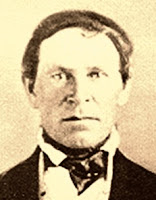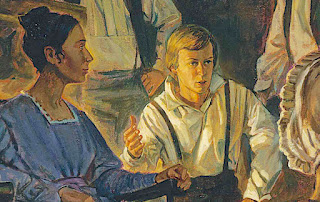While most may not even now these events took place, geologists have written much about them and there is no question among scientists of the validity of the events. The problem lies in the time frame surrounding these well documented events.
At the age of 500, the Lord told Noah
to build an ark It took him 100 years,
along with his three sons, to complete the task
The waters prevailed upon the Earth 150 days (genesis 7:24), in which they abated, and after 9½ months, Noah opened the window of the ark and sent out a dove, though the waters still prevailed on the whole earth ((Genesis 8:9). However, it was not until the 601st year, in the first moth and first day, the waters were nearly dried up off the earth (Genesis 8:13), and in the 27th day of the following month, the waters were gone completely (Genesis 8:14).
Thus, in the year 2343 BC, Shem, Ham, and Japeth went forth from the ark and the settling of the Earth commenced. This was approximately 240 years before the Jaredites built that barges and crossed the Great Deep, or oceans to the land promised to them (Ether 2:13,16-17;6:4-12) .
The point is, we either accept the scriptures or we do not. We cannot decide which scriptures we like and accept them, and decide which we do not like and reject those. The story of Noah is both well stated with details, and time frames. We know when the flood occurred and can place it within the time frame of secular history, knowing as we do that Adam preceded Noah by approximately 1656 years when he was ejected from the Garden of Eden.
It is claimed by geologists that it
take upwards of 100 million years for a mountain to completely form during the
shifting of Tectonic Plates
In addition, many cannot accept the story of Noah, because he lived to 950 years of age, building the ark at the age of 500 to 600 years of age. We are conditioned to think life ceases between 80 to 110 years under normal circumstances. Yet, the early patriarchs lived ten times as long, and Christians and LDS in particular believe in living throughout eternity in the resurrection.
However, the Lord has told us the age of the Earth since Adam left the garden of Eden, and we can track that information in the Genesis record which the Lord dictated to Moses (Moses 1:40) so we would have the truth and not be subject to the singular belief and speculation of scientists.
As an example, science claims that the geological period is one of the several subdivisions of geologic time enabling cross-referencing of rocks and geologic events from place to place. A “geon” (geologic eon) are large, geological units of time, to represent either the span of the average geologic period, or the thickness of the average stratigraphic equivalent, a matter of 60,000,000 years, and 50,000 feet of clastic depositions. They traditionally subdivide earth history into a hierarchy of named intervals, eons, eras, periods, etc., which divisions are of equal rank but characteristically of unequal duration primarily based on its fossils, artifacts, or cultural content
These periods form elements of a hierarchy of divisions into which geologists have split the Earth's history. This is all well and good, except we know from the Lord that the Earth itself is not as old as geologists claim certain rocks are, thus the idea of such reference of events is inaccurate and of no value to determine the age of the actual Earth—however, it does tell us how old parts of the universe are since these rocks were used in the forming of the Earth, and therefore are far older than the Earth itself. It would be like taking wood and nails from an 18th century barn and using them to build a new, modern barn. While the wood and nails would be much older, the barn itself as newly finished would be nowhere near as old.
Matter unorganized in the Universe
Thus, we also know from modern-day revelations that when the Earth was first organized, “the Lord said: let us go down. And they went down at the beginning and that they, that is the Gods, organized and formed the heaven and the earth” (Abraham 4:1). That is, the heaven and the earth were formed by those under the Lord’s direction, all things of which the Earth was formed came from existing material, reorganized into this modern world.
We also know that in that organizing and forming, “there was matter unorganized,” which they took and organized it into “a world like unto the other worlds we have heretofore formed,”—the global world form that is now this planet.
The reason this is so important is simply that some scriptural information is not understandable when interpreted in the terms that some scientists claim are factual, like the age of the Earth, and therefore the various ancient ages of events that took place in the Earth’s pre-history. It might be of interest to now in these divisions, it is claimed while the Earth formed about 4550 million years ago (4.55 billion), an event that is assigned to Geon 45. Rocks formed at 1851 million (1.851 Billion) or 1800 million (1.8 Billion) both belong to Geon 18. Thus, according to the geologic scale, rocks formed in a relatively short period. However, the rocks measured on the Earth vary over a very considerable difference.
A 4.03-billion year-old sample for
the small Acasta River, an obscure little drainage up near Great Bear Lake,
Northwest Territories in Canada (some age-dating now claims this material is
4.2 billion years old)
If one wasn’t so conditioned to think in a geologic time frame, one might wonder why rocks in different areas, sometimes in the same area, are of different age. One might think that if the world was created at one time from one source, such as a “Big Bang,” that its parts would be dated to the same period—like a model car built in Detroit, you don’t find a 1920 fender, a 1954 hood, a 1987 trunk and a 1999 axel—you find all parts dated to the time when the car was built. Thus, one would expect that in the forming of primordial protons and neutrons from the quark-gluon plasma of the early Universe as it cooled below two trillion degrees that the result would be somewhat similar in time measurement when the following primordial protons and neutrons formed during the process known as Big Bang nucleosynthesis.
Yet, nothing dated on the Earth of its origin is constant according to the geologic time scale—it varies over millions and millions of years, as well as billions and billions of years.
On the other hand, with the Earth being formed out of various pieces of unorganized matter as the Lord has told us, the material coming from different uses at different times, the ages of individual pieces, such as rocks, would vary considerably as we find that it does.


































